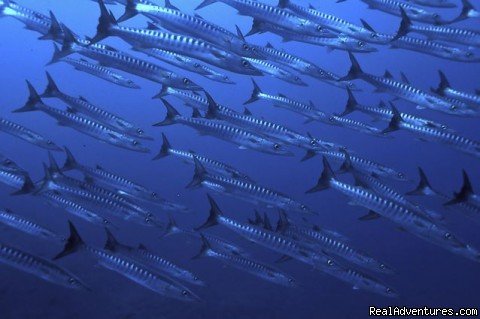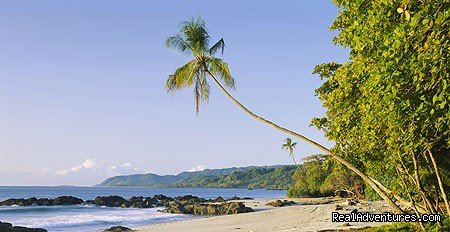History of scuba diving & adventure in Costa Rica
By Bill Beard
Less than a decade ago, Costa Rica was virtually unknown as a destination for diving. Suddenly it is being applauded for its variety and abundance of marine life. New facilities along the Pacific coastline are now offering first-class dive boats and fully stocked dive shops. And best of all, divers enjoy the excitement of truly virgin diving in areas never before explored.
Costa Rica's bid to become a player in the arena of the world's leading dive destinations didn't happen overnight. It has taken time and determination. In the 1960's bananas were the number one industry, coffee production was second, and tourism didn't exist.
When Bill Beard, widely recognized as the true pioneer of scuba diving in Costa Rica and one of the key players in bringing Costa Rica to the forefront as a dive destination made his first trek in 1970, there were no scuba tanks in the country. But on his second visit he changed that by bringing tanks in his bags, something you probably couldn't get away with today. He got his tanks filled with compressed air at the local gas company and found someone to take him out in a dug-out canoe. It wasn't difficult to see the potential for diving in Costa Rica, but it certainly wasn't easy for Bill to fulfill his dream.
To bring this vision to life meant that Bill Beard had to carve an industry where none existed. He is responsible for many firsts in Costa Rica scuba diving: the first working instructor, the first dive shop, and the first beach-based dive center to run daily scuba diving excursions.
Training of the first divers in Costa Rica came in the back of his barbeque restaurant in San Jose, where students attended classes after hours. Word spread and classes filled. It was in these first few sessions that most of the dive masters now working on Costa Rica's live aboard boats and in land-based dive operations throughout the country got their training.
It wasn't long before Bill opened Costa Rica's first professional, full-service dive shop, Mundo Acuatico, in San Pedro, which is still in operation today. In the early 1980's, Diving Safaris, owned by Bill Beard became the first beach-based dive center, getting its start in Playa del Coco, moving to Ocotal, and eventually settling in Playa Hermosa. When Bill Beard and his wife Nadine were running the day-to-day operation in the late 1980's and early 1990's they were the recipient of many awards from the scuba diving community, including No. 1 in Rodale's Scuba Diving's Top 10 Dive Operator in the Indo-Pacific and SSI's Platinum Pro 5000.
This was a period of great growth for Costa Rica's adventure tourism industry, and Bill wasn't the only one paving the way. It was during this same time that another pioneer was forming his own niche within the country. California-native, Michael Kaye, led the way in another water-based activity by opening Costa Rica's first white water river rafting company -- Costa Rica Expeditions -- in 1978.
Many rafting companies soon followed in Michae's footsteps, and Costa Rica's whitewater river rafting industry was suddenly booming. The Class 4 rapids and pristine beauty of the Pacuare and Reventazon rivers quickly garnered worldwide attention. Today the Pacuare is widely considered one of the top five rivers in the world for white water rafting. There are a number of rivers being used for rafting today and the Sarapiqui and Tenorio have also become very popular.
Michael Kaye has continued to be a leader and shaker in what has become an eco adventure-tourism mecca. Costa Rica Expeditions now owns hotels in Monteverde, Tortuguero, and Corcovado. Michael and his company have received several awards from Conde Naste and the Travel & Leisure for sustaining eco-tourism.
Scuba diving got another big boost in the 1980's when Tomas Pozuelo, owner of Jack's and Pozuelo, Costa Rica's largest cookie and snack companies, bought the Okeanos Agressor. Getting the permits necessary to bring this vessel to the area enabled scuba divers to enjoy the beauty and electric diving at the Cocos Islands. Doing this really put Costa Rica on the map as one of the world's top ten dive destinations. Its beauty is unsurpassed, and it is famous known for its large schools of hammerheads, rays, and other pelagics. Many times it has been voted No. 1 in Rodale's Top 10 Dive Destinations and Top 10 Dive Liveaboards. The Okeanos Agressor was joined at the Cocos Islands in the 1990's by two additional liveaboard vessels owned by Avi Klapper: the Sea Hunter and the Undersea Hunter.
The deep-sea sport fishing industry was taking off in the early 80's with new hotels and the countries first marina being built in Flamingo. Until that time most of the sport fishing boats were based at Ocotal and Bahia Pez Vela. There was a shortage of nice fishing boats and Dennis Garrett started filling that void by designing and building a wonderful 32-foot sport fishing boat in Costa Rica. Many of the 117 world's records set during the 1980's to the late 1990's on Costa Rica's Pacific coast and the Barrio del Colorado on the Caribbean side still stand today. One thing that helped the industry was Costa Rica initiating and supporting the catch and release program that has helped assure there are always plenty of fish.
In the 1990's, Canadian Darren Hrenluk, opened the Original Canopy Tour and the complexion of eco-tourism changed again. This unique, exhilarating, and exotic experience fit well in Costa Rica's natural landscape.
Everyone had their own niche market, but no one was packaging these activities together. Avid river rafters came to San Jose, but didn't make the four-hour trek to the Pacific beaches. Scuba divers went to the Pacific coast or Cocos Islands, bur rarely saw the rest of the county, with the exception of the transfer to and from the San Jose airport. Fishermen flew on prop planes to where the fish were biting before returning to San Jose.
The first scuba diving tourists to come to the Pacific were so much in awe of the sights they were being treated to under water that they often left Costa Rica without seeing any of the topside beauty. To participate in the white water rafting it was necessary to overnight in San Jose, and most scuba divers weren't willing to give up two nights of their week-long dive vacation.
However, it was natural to combine turtle nesting and hatching tours or scenic, tranquil river floats to the scuba divers itineraries as they were nearby. Divers visiting land-based operations were still diving five or six days, but in the early 1980's we recognized the need to maximize their vacation time. The divers began doing a few tours in the afternoon and seeing the turtles at night, but they were still leaving Costa Rica without experiencing the volcanoes and rainforest so many planned a second and third trip back to the country.
By the year 2000, a wide variety of activities such as hanging bridges, aerial trams, ATV's and canyoning treks had sprung up in every corner of the country. Canopy tours became ubiquitous. According to a recent survey by the ICT (National Tourism Institute) 85% of all tourists now reported that a canopy tour was on their list of must do's while visiting Costa Rica.
Many things changed the face of tourism in Costa Rica, but it was the opening of the Daniel Oduber International airport in Liberia that put the ability to provide combination adventure tour packages over the top. More than 40 flights a week bring over 100,000 passengers a year into Liberia and the Guanacaste province. Tourism is now the leading industry in Costa Rica, leaving bananas and coffee far behind in its wake.
Instead of having to drive four hours from San Jose to enjoy the offerings of the Pacific regions and Guanacaste, the region the majority of tourists prefer to visit, there was now have the choice to fly directly into Liberia. From Liberia visitors can be at many of the Pacific beach resorts in half an hour to an hour.
Maximizing your vacation time has become a breeze. Fly into Liberia, spend time snorkeling or diving while staying at the Pacific beaches with their gorgeous views, travel by car or van to Monteverde Cloud Forest Preserve, make the crossing by boat to Arenal Volcano for the hot springs, canopy tours, ATV's, and canyoning. Make a wild river raft down the Sarapiqui, take out in a verdant rain forest, and fly out of San Jose.
The visionaries who created the ecotourism market in Costa Rica overcame many hurdles, but the only challenge facing you today is to decide which activities will make your vacation dreams come true.
 Pacific Baracuda (Sphyraena ensis) (enlarge)
Pacific Baracuda (Sphyraena ensis) (enlarge)
